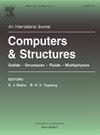Fragment prediction of reinforced concrete wall under close-in explosion using Fragment Graph Network (FGN)
IF 4.4
2区 工程技术
Q1 COMPUTER SCIENCE, INTERDISCIPLINARY APPLICATIONS
引用次数: 0
Abstract
Reinforced concrete (RC) walls are vulnerable to severe damage under high-intensity, close-in TNT explosions. Substantial secondary fragments at high ejecting velocities could be generated from the damaged wall, posing serious threats to people, facilities and structures in the area. Predicting the blast-induced secondary fragments remains a great challenge. Traditional computational methods, such as the finite element method (FEM) or meshfree methods, are often used to predict the fragment characteristics despite their inherent problems, such as the application of erosion and predefining the weak sections in the simulation. They also require high computational power to perform the simulation, thus limiting their use in creating an adequate dataset to thoroughly analyse the characteristics of secondary fragments and the associated threats. This study employs a recently developed machine learning-based approach named Fragment Graph Network (FGN), a variant of Graph Neural Networks (GNNs), to generate a large dataset of fragment characteristics. This FGN model can efficiently predict the fragment mass, size, and velocity with a significantly reduced computational cost. Intensive predictions of fragments from different wall configurations and explosion intensities are carried out. The results are used to develop analytical formulae for predicting secondary fragments of RC walls subjected to close-in explosions.
利用碎片图网络(FGN)预测近距离爆炸下钢筋混凝土墙的碎片情况
钢筋混凝土 (RC) 墙在高强度、近距离 TNT 爆炸下容易受到严重破坏。受损墙体可能会以较高的抛射速度产生大量二次碎片,对该区域的人员、设施和结构造成严重威胁。预测爆炸诱发的二次碎片仍是一项巨大挑战。传统的计算方法,如有限元法(FEM)或无网格法,尽管存在固有的问题,如应用侵蚀和在模拟中预先确定薄弱部分,但仍经常用于预测碎片特征。这些方法还需要很高的计算能力来进行模拟,因此限制了它们在创建足够的数据集以彻底分析二次碎片的特征和相关威胁方面的应用。本研究采用了最近开发的一种基于机器学习的方法,名为 "碎片图网络(FGN)",它是图神经网络(GNN)的一种变体,用于生成大量碎片特征数据集。这种 FGN 模型可以有效预测碎片的质量、大小和速度,同时大幅降低计算成本。对不同壁面配置和爆炸强度产生的碎片进行了深入预测。预测结果用于开发分析公式,用于预测近距离爆炸时 RC 墙体的二次碎片。
本文章由计算机程序翻译,如有差异,请以英文原文为准。
求助全文
约1分钟内获得全文
求助全文
来源期刊

Computers & Structures
工程技术-工程:土木
CiteScore
8.80
自引率
6.40%
发文量
122
审稿时长
33 days
期刊介绍:
Computers & Structures publishes advances in the development and use of computational methods for the solution of problems in engineering and the sciences. The range of appropriate contributions is wide, and includes papers on establishing appropriate mathematical models and their numerical solution in all areas of mechanics. The journal also includes articles that present a substantial review of a field in the topics of the journal.
 求助内容:
求助内容: 应助结果提醒方式:
应助结果提醒方式:


